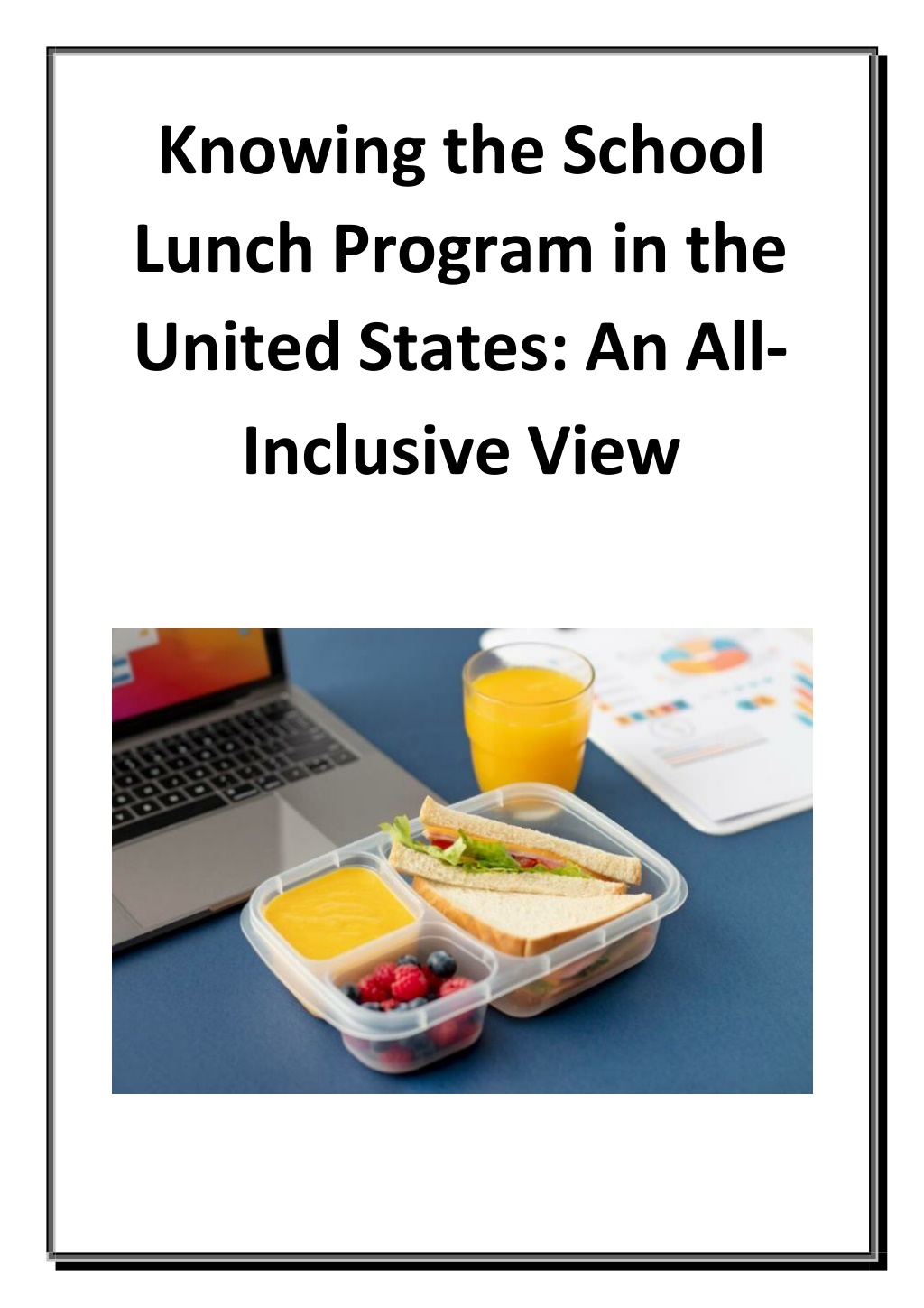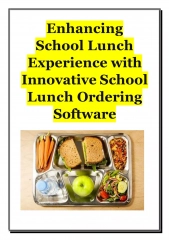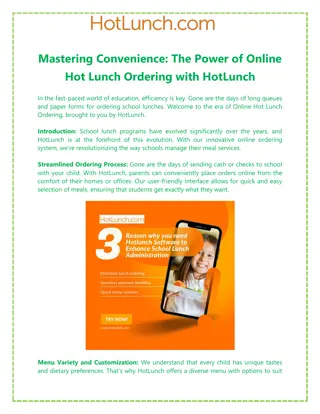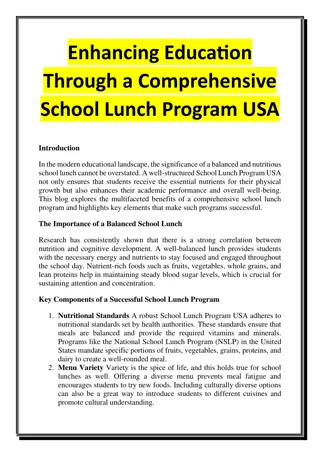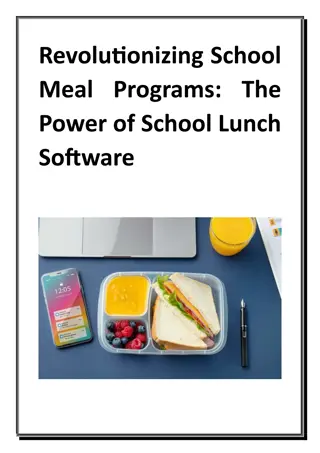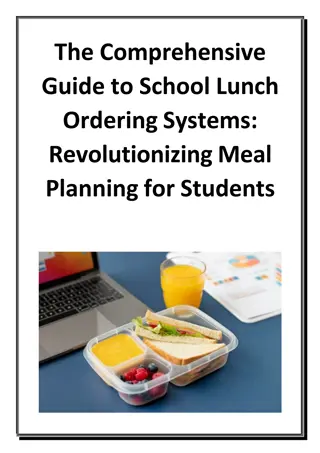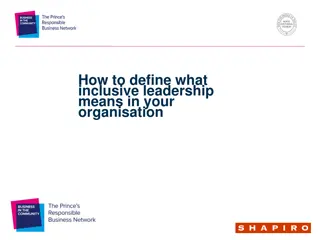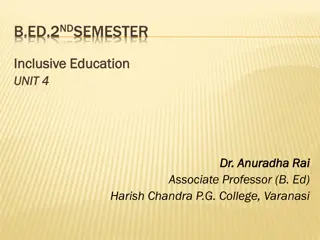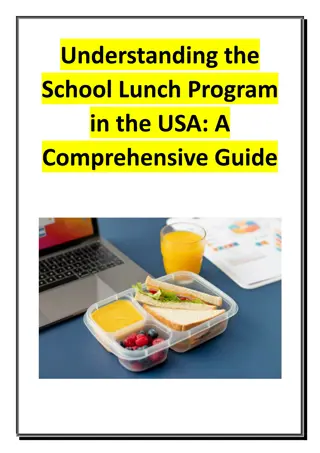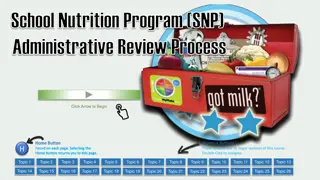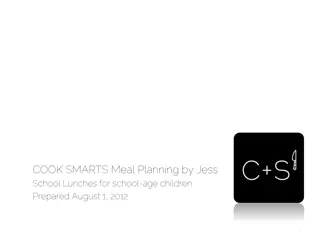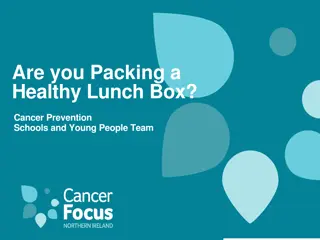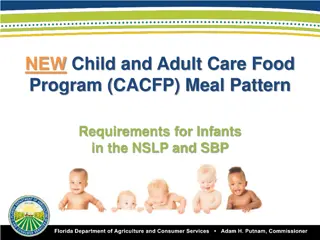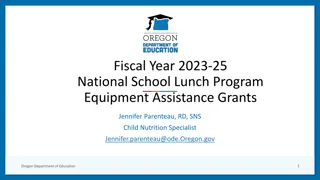Knowing the School Lunch Program in the United States - An All-Inclusive View
For millions of students in the United States, the School Lunch Program is not just a meal but also a vital part of public health policy. Understanding its background, advantages, and difficulties helps us appreciate its great part in advancing the h
Uploaded on Aug 29, 2024 | 4 Views
Download Presentation

Please find below an Image/Link to download the presentation.
The content on the website is provided AS IS for your information and personal use only. It may not be sold, licensed, or shared on other websites without obtaining consent from the author. Download presentation by click this link. If you encounter any issues during the download, it is possible that the publisher has removed the file from their server.
E N D
Presentation Transcript
Knowing the School Lunch Program in the United States: An All- Inclusive View
Administered by the Food and Nutrition Service (FNS) of the United States Department of Agriculture (USDA), the School Lunch Program (SLP) is government-supported. Millions of students in the United States depend on the school lunch program as a critical service that daily provide wholesome meals. This School Lunch Program USA is very important in boosting children's health and academic success as it guarantees that every student, from whatever household economic level, has access to good meals. From providing well balanced meals to encouraging improved eating habits, the school lunch program is a vital component of the educational process. Originally started under the National School Lunch Act of 1946, the initiative seeks to provide public and nonprofit private school students with low-cost, nutritionally adequate meals, either free or subsidized. Originally designed to advance American children's health and welfare, the School Lunch Program has changed dramatically to serve millions of kids nationwide. The Changing School Lunch Program Responding to changing nutritional recommendations, public health trends, and growing concerns about kid obesity and malnutrition, the School Lunch Program USA has evolved. Originally mostly intended to reduce children's hunger, especially in times of economic crisis, the program has now shifted its emphasis to include nutrition education and awareness. The Healthy, Hunger-Free Kids Act was passed in 2010 and included several significant reforms along with the reauthorising of the SLP. Among these modifications were revised dietary recommendations shaped by the 2010 Dietary Guidelines for Americans. While limiting the amounts of saturated fat, trans fats, and salt in school meals, schools were obliged to include more fruits, vegetables, healthy grains, and low-fat dairy products. Essential Characteristics of the School Lunch Program Access and Eligibility Every day, the School Lunch Program feeds millions of kids; precise qualifying rules help to guarantee that those in need get help. Children from households with incomes up to 130% of the federal poverty line often qualify for free meals; those from families with incomes between 130% and 185% qualify for discounted-price lunches. This tiered strategy guarantees that low-income homes and a great portion of the population can afford school meals.
Guidelines for Nutrition The School Lunch Program USA is distinguished, among other things, by its dedication to nutrition. The USDA lays down rigorous rules on the meals allowed in educational settings. These comprise: Schools must provide fruits and vegetables daily, with an eye towards diversity, to encourage consumption. At least half of the grains presented should be whole grains, enhancing the nutritious value. Schools must provide lean proteins such as chicken, fish, beans, and lentils. Standard is low-fat or fat-free milk, which helps to reduce saturated fat consumption. Following these dietary guidelines helps the SLP, and the hope is to encourage better eating habits early on in children. Ad advantages of the school lunch program The School Lunch Program has advantages beyond just feeding hungry students. These are some noteworthy benefits: Fighting Food Insecurity and Hunger Particularly important for individuals from food-insecure homes, the SLP is essential to ensure kids have at least one healthy meal daily. Healthy food access enhances academic achievement, and well-fed youngsters are likelier to shine academically. Encouragement of Good Habits The SLP promotes lifetime healthy practices in children by providing classroom meals. Students who have access to a range of nutritious meals and meal alternatives are more likely to have a good connection with food, which will guide their adult eating decisions. Supporting Regional Economies Furthermore, the School Lunch Program may be very important for nearby suppliers and farmers. Many school systems acquire their food locally, promoting Farm-to-- School projects and local agriculture.
Issues Affecting the School Lunch Program The SLP does have difficulties, even if it has many advantages. The general efficacy of the program might be hampered by budget restrictions, different rates of participation, and the stigma connected with getting free or reduced- price meals. Furthermore, some detractors contend that the nutritional guidelines occasionally overlook culturally appropriate food alternatives, which emphasizes the need for schools to be aware of the many communities they handle. Conclusion: Foundation of Educational Well-Being For millions of students in the United States, the School Lunch Program is not just a meal but also a vital part of public health policy. Understanding its background, advantages, and difficulties helps us appreciate its great part in advancing the health and welfare of America's young people. Maintaining every child's access to wholesome meals depends on ongoing support and program development, enabling physical and intellectual growth. Ultimately, the School Lunch Program USA is evidence of the United States' will to make investments in the future of its citizens a clear admission that education is intrinsically related to health. There is promise for a better, healthier future for young Americans, given continuous attempts to improve the program and handle its issues.
